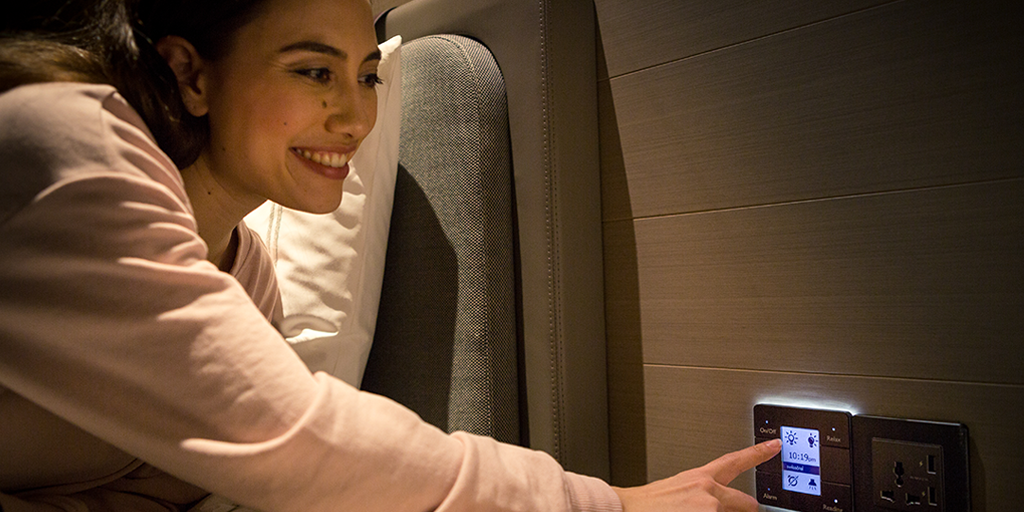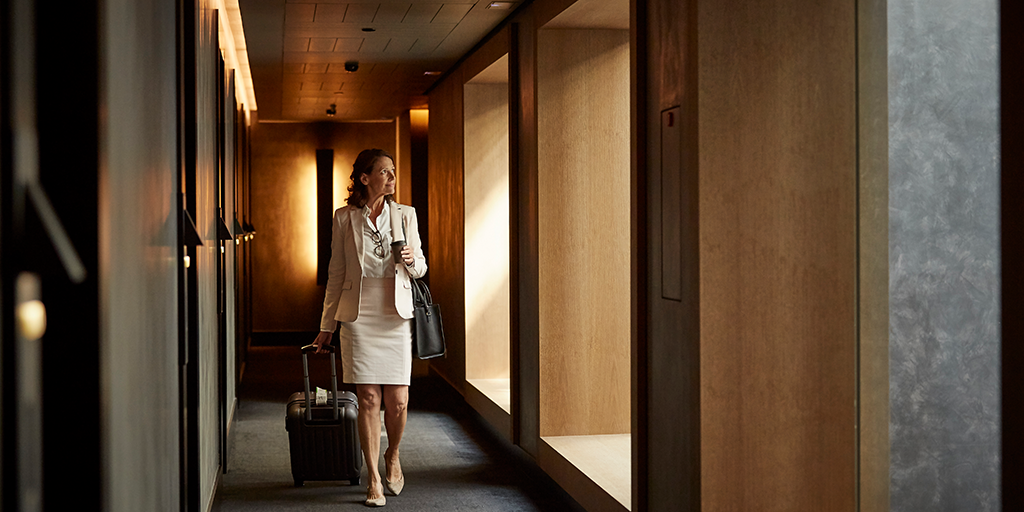Travelers have an ever-increasing choice in places to stay, with the recent travel restrictions only fueling their desire to enjoy new experiences and destinations. One way that hotels can achieve this is by embedding technology into their guest rooms, streamlining interactions for the guest while ensuring consistent energy management for the operator. Building on this foundation, a broad range of personalization can be offered to create rich, memorable experiences for guests.
Enhancing guest experiences with smart lighting and controls
Travelers have an ever-increasing choice in places to stay, with the recent travel restrictions only fueling their desire to enjoy new experiences and destinations. Delivering this, with features appropriate to your audience, can be key to attracting guests and building loyalty. More than ever, guests are freely posting opinions and reviews online—both good and bad—with every detail open to inclusion.
While the definition of “experience” may vary across different star ratings, one constant remains: whether on business or leisure, guests always want a room that is intuitive to use, and they want to personalize it to match their moods and activities throughout their stay.
One way that hotels can achieve this is by embedding technology into their guest rooms, streamlining interactions for the guest while ensuring consistent energy management for the operator. Building on this foundation, a broad range of personalization can be offered to create rich, memorable experiences for guests.
Smart lighting makes guests feel good
Great lighting can perfectly compliment an interior design, providing guests with enhanced comfort whether they are relaxing or working. Combined with smart controls, LED lighting can enhance guests’ experiences from the moment they arrive at their room. Nothing makes a better first impression of a guest room than a perfectly presented welcome experience: lighting set to complement the time of day, the room cooled or heated for optimum comfort, and curtains automatically opening on entry to frame a beautiful view of the city or beach.
Once inside, whether from a keypad or next-generation interface on the TV, tablet, or app, guests can be in full control of their space. Depending on the hotel tier, lighting scenes can be created with either switched groups of circuits or smooth dimming. Guests can be only a single tap away from a mood or activity based scene.
For the most immersive environments, lighting can be enhanced with tunable white control—not just dimming, but tuning the light to appear warmer or cooler. Imagine a work lighting scene that brings not just brighter, focused light to the desktop, but also a cooler, crisper white light that enhances focus. Or conversely, when a guest is ready to wind down or watch a movie at the end of the day, a relax scene that is not just dimmer but that also has a soft, warm feel to help prepare for a great night’s sleep.
On the exterior, lighting can create a special atmosphere too. Well-designed lighting can enhance beautiful landscaping, open-air dinners on the deck or help guests safely navigate their way back to their room or villa, all without creating unwanted light spill that might disturb other guests.
Smart controls can easily manage seamless transitions throughout the day, whether linked to different settings or facility open hours or automatically following sunrise and sunset. They allow the easy creation of different states of not just lighting, but also power, HVAC, drapery and fans. Thoughtful features like these can help guests feel comfortable, secure, and well-served wherever they go on the property.
Smart lighting helps guests sleep well and find their way overnight
After a relaxing lighting scene in guestrooms, guests are ready for a great night’s sleep.
Traditionally, more than one-third of guests keep the bathroom light turned overnight to help them navigate in case they wake up later. However, this does not help in creating the best environment for sleep, which should be as close to blackout as possible.
With smart controls, a single “master off” button at the bedside can not only fade all the room lighting to darkness, but it an also activate discreet nightlight sensors. Should a guest wake up overnight, as soon as their feet hit the floor, low-level lighting is activated, helping them safely navigate. Using the room’s smart occupancy detection, the lighting can stay on for as long as they need to visit the bathroom or get a drink, then fade smoothly back to darkness as soon as they return to bed.
It’s a seamless experience for guests, helping them safely navigate overnight without disturbing their partner or their own quality of sleep. For operators, it provides additional energy savings as bathroom lights are no longer left on all night.
Smart lighting is smart in the morning, too
After a great night’s sleep, smart lighting and controls can also wake guests up in the most natural and energizing way. Set just like a normal wake-up alarm, smart lighting and controls can offer a simulated sunrise, designed to wake guests up in the same natural way as the rising sun. Research confirms that the extended use of such a sequence leaves people feeling more refreshed and energized for the day ahead.
Forms of bio-adaptive lighting like this support the body’s circadian rhythm, and can be particularly important for guests who have traveled across several time zones. Delivering the right light spectrum in the morning. for example, can help a guest’s body clock to conform to local time, stimulating the production of the hormone cortisol and minimizing the effects of jet lag.
Hotels that offer rich, immersive environments like these can count on the fact that guests will associate their sense of well-being with the hotel environment—encouraging return visits in the future.
Multipurpose spaces and business centers
Intelligent lighting and control extends to areas across the whole hotel or resort as well, contributing to great experiences for both guests and visitors alike. In a bar or restaurant for example, lighting can help transform a space throughout the different sittings of a day. Bright, crisp white light can help energize people at breakfast, while comfortable lighting can enhance business lunches and family dinners. The lighting can then transition to a more intimate, cozy setting for late-night drinks.
In ballrooms and conference centers, tunable white lighting help create spaces that can be used for multiple purposes in a single day—crisp white light for exhibitions and conferences during the day for example, moving to warmer lighting when hosting a gala dinner or a wedding in the evening. Color-changing cove lighting helps to reflect seasonal celebrations or allows companies to reflect their brand colors during an event.
In a hotel’s gym or spa facility, lighting can provide custom illumination based to the time of day or available on demand to suit a class or activity. Crisp bright light can be stimulating for aerobic exercise, while a reduced level of softer light can be ideal for yoga and pilates.
Dynamic outdoor lighting can enhance hotel façades in countless and striking ways—from elegant lighting that highlights interesting architectural detail to full-color light shows across the façade, making the hotel into a local attraction, enhancing the hotel’s brand, or joining with seasonal celebrations.
Guests are always in control
After initially resetting the room to hotel defaults upon check-in and presenting the room with a welcome scene, controls can automatically store and resume guest personalization or preferences made throughout a stay. When guests are away from the room, controls can switch lights off, close the curtains, and step back the heating or cooling, immediately resuming them to the previous settings when the guests return.
Such automation, powered by smart controls, should be silent and invisible to guests, seamlessly creating reliable energy savings for operators while providing the most comfortable environment for guests.
Then in the room, guests are always in full control, able to personalize the environment as they wish.
Smart experiences are green experiences
The most effective smart controls for hotels offer the lighting capabilities described above—and much more. When integrated with control systems for other hotel services—HVAC, check-in and check-out, guest requests and more, systems can give hotel managers and operators visibility over a hotel’s complete operations.
Integration allows for proactive alerts when something is not quite right, as well as energy monitoring to help identify rooms that are consuming more than expected. Analyzing how guests personalize settings can also help operators make informed, fact-based changes to hotel defaults, empowering teams and helping properties become ever greener over time.
With the growing awareness of human impact on the climate, more and more guests are choosing to stay with brands that embrace sustainable practices. In this way, energy-efficiency features can enhance a hotel’s brand, create positive savings, and contribute to enhancing guest satisfaction. That’s a triple win: for the hotel operator, the hotel guest, and the planet itself.






